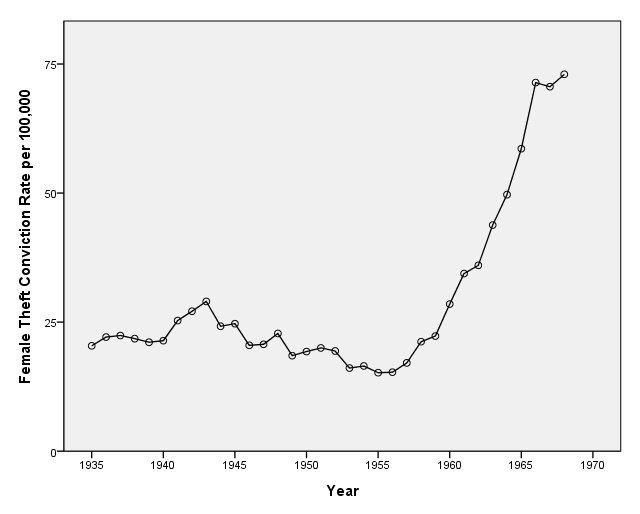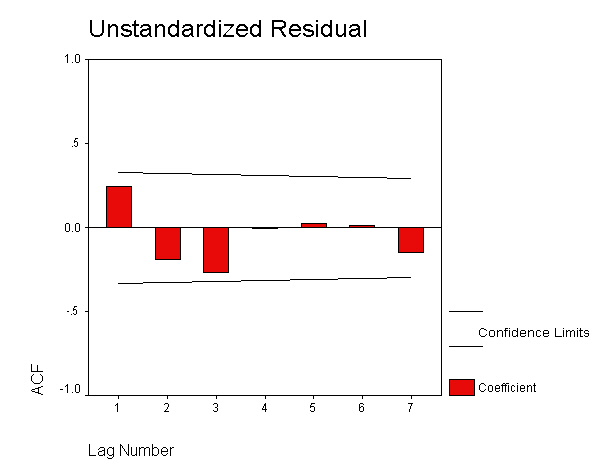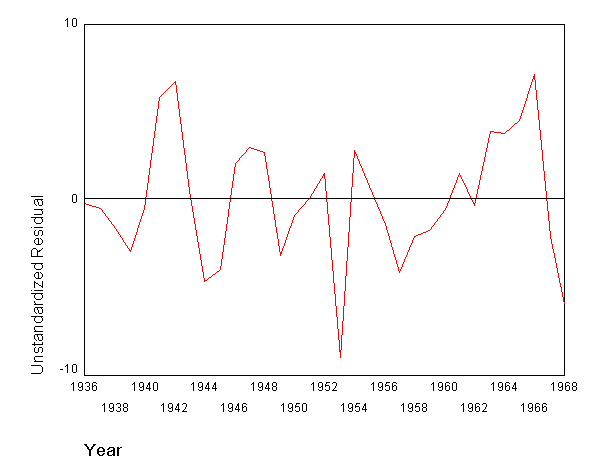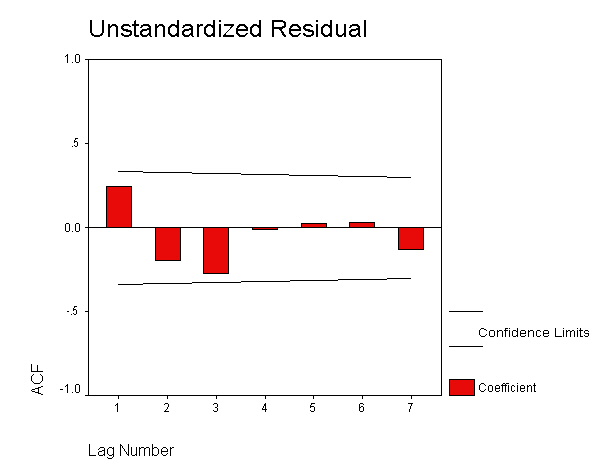page 380 Figure 14.3 Canadian women’s theft conviction rate per 100,000 population, for the period 1935-1968.
GET FILE='D:hartnagl.sav'.
formats ftheft (f2.0).
GGRAPH
/GRAPHDATASET NAME="graphdataset" VARIABLES=year ftheft
/GRAPHSPEC SOURCE=INLINE.
BEGIN GPL
SOURCE: s=userSource(id("graphdataset"))
DATA: year=col(source(s), name("year"))
DATA: ftheft=col(source(s), name("ftheft"))
GUIDE: axis(dim(1), label("Year"), start(0.0), delta(5.0))
GUIDE: axis(dim(2), label("Female Theft Conviction Rate per 100,000"), start(0.0), delta(25.0))
SCALE: linear( dim( 1 ), min(1935), max(1970) )
SCALE: linear( dim( 2 ), min(0), max(75) )
ELEMENT: line(position(year*ftheft))
ELEMENT: point(position(year*ftheft))
END GPL.

page 380 Table 14.1 Regression of Canadian women's theft conviction rate on several independent variables, for the period 1935 to 1968: total fertility rate (TFR); labor force participation rate (LFPR); postsecondary degree rate (PSDR); and men's theft conviction rate (MRCR). The first set of EGLS estimates uses all 34 observations; the second set of EGLS estimates drops the first observation.
OLS
regression /dep=ftheft /method=enter fertil labor postsec mtheft /save res.
| Model | Variables Entered | Variables Removed | Method |
|---|---|---|---|
| 1 | Male Theft Conviction Rate per 100,000, Fertility Rate per 1000, Labor Force Participation Rate per 1000, Post Secondary Degree Rate per 1000(a) | . | Enter |
| a All requested variables entered. | |||
| b Dependent Variable: Female Theft Conviction Rate per 100,000 | |||
| Model | R | R Square | Adjusted R Square | Std. Error of the Estimate |
|---|---|---|---|---|
| 1 | .976(a) | .953 | .947 | 3.81245 |
| a Predictors: (Constant), Male Theft Conviction Rate per 100,000, Fertility Rate per 1000, Labor Force Participation Rate per 1000, Post Secondary Degree Rate per 1000 | ||||
| b Dependent Variable: Female Theft Conviction Rate per 100,000 | ||||
| Model | Sum of Squares | df | Mean Square | F | Sig. | |
|---|---|---|---|---|---|---|
| 1 | Regression | 8545.522 | 4 | 2136.380 | 146.984 | .000(a) |
| Residual | 421.509 | 29 | 14.535 | |
|
|
| Total | 8967.031 | 33 | |
|
|
|
| a Predictors: (Constant), Male Theft Conviction Rate per 100,000, Fertility Rate per 1000, Labor Force Participation Rate per 1000, Post Secondary Degree Rate per 1000 | ||||||
| b Dependent Variable: Female Theft Conviction Rate per 100,000 | ||||||
| |
Unstandardized Coefficients | Standardized Coefficients | t | Sig. | ||
|---|---|---|---|---|---|---|
| Model | B | Std. Error | Beta | |||
| 1 | (Constant) | -7.334 | 9.438 | |
-.777 | .443 |
| Fertility Rate per 1000 | -6.090E-03 | .001 | -.179 | -4.202 | .000 | |
| Labor Force Participation Rate per 1000 | .120 | .023 | .267 | 5.124 | .000 | |
| Post Secondary Degree Rate per 1000 | .552 | .043 | .684 | 12.753 | .000 | |
| Male Theft Conviction Rate per 100,000 | 3.932E-02 | .019 | .097 | 2.119 | .043 | |
| a Dependent Variable: Female Theft Conviction Rate per 100,000 | ||||||
| |
Minimum | Maximum | Mean | Std. Deviation | N |
|---|---|---|---|---|---|
| Predicted Value | 13.7209 | 79.0028 | 29.1294 | 16.09208 | 34 |
| Residual | -8.9739 | 7.1652 | .0000 | 3.57393 | 34 |
| Std. Predicted Value | -.958 | 3.099 | .000 | 1.000 | 34 |
| Std. Residual | -2.354 | 1.879 | .000 | .937 | 34 |
| a Dependent Variable: Female Theft Conviction Rate per 100,000 | |||||
EGLS(1)
ACF VARIABLES= res_1 /NOLOG /MXAUTO 7 /SERROR=IND.
MODEL: MOD_4.
Variable: RES_1 Missing cases: 4 Valid cases: 34
Autocorrelations: RES_1 Unstandardized Residual
Auto- Stand.
Lag Corr. Err. -1 -.75 -.5 -.25 0 .25 .5 .75 1 Box-Ljung Prob.
1 .244 .164 . ***** . 2.212 .137
2 -.192 .162 . **** . 3.621 .164
3 -.265 .159 .***** . 6.404 .094
4 .000 .157 . * . 6.404 .171
5 .025 .154 . * . 6.430 .267
6 .017 .151 . * . 6.442 .376
7 -.149 .149 . *** . 7.444 .384
Plot Symbols: Autocorrelations * Two Standard Error Limits .
Total cases: 38 Computable first lags: 33

NOTE: The autocorrelation for the first lag is .2442.
compute fth1 = ftheft-0.244*lag(ftheft). /*using transformation on page 378*/ compute fer1=fertil-0.244*lag(fertil). compute lab1 =labor-0.244*lag(labor). compute pos1 = postsec-0.244*lag(postsec). compute mth1 =mtheft-0.244*lag(mtheft). compute cons = .756. if ($casenum=5) fth1 = sqrt(1-.244*.244)*ftheft. if ($casenum=5) fer1 = sqrt(1-.244*.244)*fertil. if ($casenum=5) lab1 = sqrt(1-.244*.244)*labor. if ($casenum=5) pos1 = sqrt(1-.244*.244)*postsec. if ($casenum=5) mth1 = sqrt(1-.244*.244)*mtheft. if ($casenum=5) cons = sqrt(1-.244*.244). execute. regression /origin /dep=fth1 /method=enter cons fer1 lab1 pos1 mth1.
| Model | Variables Entered | Variables Removed | Method |
|---|---|---|---|
| 1 | MTH1, POS1, FER1, LAB1, CONS(a) | . | Enter |
| a All requested variables entered. | |||
| b Dependent Variable: FTH1 | |||
| c Linear Regression through the Origin | |||
| Model | R | R Square(a) | Adjusted R Square | Std. Error of the Estimate |
|---|---|---|---|---|
| 1 | .991(b) | .983 | .980 | 3.66515 |
| a For regression through the origin (the no-intercept model), R Square measures the proportion of the variability in the dependent variable about the origin explained by regression. This CANNOT be compared to R Square for models which include an intercept. | ||||
| b Predictors: MTH1, POS1, FER1, LAB1, CONS | ||||
| Model | Sum of Squares | df | Mean Square | F | Sig. | |
|---|---|---|---|---|---|---|
| 1 | Regression | 22417.159 | 5 | 4483.432 | 333.755 | .000(a) |
| Residual | 389.566 | 29 | 13.433 | |
|
|
| Total | 22806.725(b) | 34 | |
|
|
|
| a Predictors: MTH1, POS1, FER1, LAB1, CONS | ||||||
| b This total sum of squares is not corrected for the constant because the constant is zero for regression through the origin. | ||||||
| c Dependent Variable: FTH1 | ||||||
| d Linear Regression through the Origin | ||||||
| |
Unstandardized Coefficients | Standardized Coefficients | t | Sig. | ||
|---|---|---|---|---|---|---|
| Model | B | Std. Error | Beta | |||
| 1 | CONS | -6.643 | 11.120 | -.196 | -.597 | .555 |
| FER1 | -5.879E-03 | .002 | -.575 | -3.305 | .003 | |
| LAB1 | .116 | .027 | .928 | 4.268 | .000 | |
| POS1 | .536 | .050 | .549 | 10.708 | .000 | |
| MTH1 | 3.993E-02 | .022 | .284 | 1.817 | .080 | |
| a Dependent Variable: FTH1 | ||||||
| b Linear Regression through the Origin | ||||||
EGLS(2)
filter off. use 6 thru 38. execute. regression /origin /dep=fth1 /method=enter cons fer1 lab1 pos1 mth1.
| Model | Variables Entered | Variables Removed | Method |
|---|---|---|---|
| 1 | MTH1, POS1, FER1, LAB1, CONS(a) | . | Enter |
| a All requested variables entered. | |||
| b Dependent Variable: FTH1 | |||
| c Linear Regression through the Origin | |||
| Model | R | R Square(a) | Adjusted R Square | Std. Error of the Estimate |
|---|---|---|---|---|
| 1 | .991(b) | .983 | .980 | 3.72183 |
| a For regression through the origin (the no-intercept model), R Square measures the proportion of the variability in the dependent variable about the origin explained by regression. This CANNOT be compared to R Square for models which include an intercept. | ||||
| b Predictors: MTH1, POS1, FER1, LAB1, CONS | ||||
| Model | Sum of Squares | df | Mean Square | F | Sig. | |
|---|---|---|---|---|---|---|
| 1 | Regression | 22027.486 | 5 | 4405.497 | 318.041 | .000(a) |
| Residual | 387.856 | 28 | 13.852 | |
|
|
| Total | 22415.342(b) | 33 | |
|
|
|
| a Predictors: MTH1, POS1, FER1, LAB1, CONS | ||||||
| b This total sum of squares is not corrected for the constant because the constant is zero for regression through the origin. | ||||||
| c Dependent Variable: FTH1 | ||||||
| d Linear Regression through the Origin | ||||||
| |
Unstandardized Coefficients | Standardized Coefficients | t | Sig. | ||
|---|---|---|---|---|---|---|
| Model | B | Std. Error | Beta | |||
| 1 | CONS | -5.519 | 11.737 | -.160 | -.470 | .642 |
| FER1 | -6.080E-03 | .002 | -.590 | -3.210 | .003 | |
| LAB1 | .114 | .028 | .904 | 4.047 | .000 | |
| POS1 | .534 | .051 | .550 | 10.466 | .000 | |
| MTH1 | 4.071E-02 | .022 | .285 | 1.815 | .080 | |
| a Dependent Variable: FTH1 | ||||||
| b Linear Regression through the Origin | ||||||
page 381 Figure 14.4 Residuals from the OLS regression of women's theft conviction rate on several independent variables.
tsplot variables = res_1 /id = year /nolog /format nofill reference. MODEL: MOD_5.
page 382 Figure 14.5 Residual autocorrelations from the OLS regression of women's theft conviction rates on several independent variables. The horizontal lines are at 0 and +-2 approximate standard errors.
ACF VARIABLES= res_1 /NOLOG /MXAUTO 7 /SERROR=IND.
MODEL: MOD_6.
Autocorrelations: RES_1 Unstandardized Residual
Auto- Stand.
Lag Corr. Err. -1 -.75 -.5 -.25 0 .25 .5 .75 1 Box-Ljung Prob.
1 .244 .166 . ***** . 2.144 .143
2 -.194 .164 . **** . 3.552 .169
3 -.271 .161 .***** . 6.369 .095
4 -.008 .158 . * . 6.371 .173
5 .024 .156 . * . 6.394 .270
6 .032 .153 . * . 6.437 .376
7 -.131 .150 . *** . 7.203 .408
Plot Symbols: Autocorrelations * Two Standard Error Limits .
Total cases: 33 Computable first lags: 32

page 399 Table 14.2 Population of the United States, in millions, 1790-1990.
GET FILE='D:us-pop.sav'.
list year pop.
YEAR POP
1790 3.93
1800 5.31
1810 7.24
1820 9.64
1830 12.87
1840 17.07
1850 23.19
1860 31.44
1870 39.82
1880 50.16
1890 62.95
1900 76.00
1910 91.97
1920 105.71
1930 122.78
1940 131.67
1950 150.70
1960 179.32
1970 203.30
1980 226.54
1990 248.71
Number of cases read: 21 Number of cases listed: 21
page 400 Figure 14.9 Panel (a) shows the population of the United States from 1790 through 1990; the line represents the fitted logistic growth model. Residuals from the logistic growth model are plotted against time in panel (b).
compute myear = year - 1790. execute.
NOTE: The model is Y = b1/(1 + exp(-b2*(X-b3))).
model program b1 = 350 b2 = .3 b3 = 15.
compute pred = b1/(1 + exp(-b2*(myear-b3))) .
nlr pop /save pred resid.
All the derivatives will be calculated numerically.
The following new variables are being created:
Name Label
PRED Predicted Values
RESID Residuals
Iteration Residual SS B1 B2 B3
1 1312135.325 350.000000 .300000000 15.0000000
1.1 100157.1798 100.435896 .146786774 18.0029445
2 100157.1798 100.435896 .146786774 18.0029445
2.1 314792.0424 108.967416 -.19655968 37.0782489
2.2 301359.2381 105.284961 -.15175500 26.9039676
2.3 96429.25332 100.305195 .093343940 18.3767624
3 96429.25332 100.305195 .093343940 18.3767624
3.1 113742.0106 101.936425 .005176064 18.9207181
3.2 94592.41883 100.419596 .077744762 18.4418469
4 94592.41883 100.419596 .077744762 18.4418469
4.1 89669.44906 100.864638 .052037091 18.5681848
5 89669.44906 100.864638 .052037091 18.5681848
5.1 80711.39660 102.880241 .020214578 18.7917751
6 80711.39660 102.880241 .020214578 18.7917751
6.1 75761.30175 117.004359 .016667397 19.6920945
7 75761.30175 117.004359 .016667397 19.6920945
7.1 71329.26105 125.989041 .018832793 25.4549182
8 71329.26105 125.989041 .018832793 25.4549182
8.1 68126.93436 138.787646 .013482007 37.2700619
9 68126.93436 138.787646 .013482007 37.2700619
9.1 72026.92171 100.475331 .037261255 42.1331140
9.2 63743.31292 124.745379 .026231247 38.7300148
10 63743.31292 124.745379 .026231247 38.7300148
10.1 60371.83427 133.485133 .020449860 43.3845176
11 60371.83427 133.485133 .020449860 43.3845176
11.1 56267.71992 132.732592 .027346079 48.1835689
12 56267.71992 132.732592 .027346079 48.1835689
12.1 49140.29896 142.947629 .022777747 58.6348198
13 49140.29896 142.947629 .022777747 58.6348198
13.1 30900.04519 151.434468 .031779839 80.1714005
14 30900.04519 151.434468 .031779839 80.1714005
14.1 18286.94843 201.327451 .020421669 122.589280
15 18286.94843 201.327451 .020421669 122.589280
15.1 7706.823633 284.259383 .025776237 163.309783
16 7706.823633 284.259383 .025776237 163.309783
16.1 604.5219428 382.090975 .021506139 176.849371
17 604.5219428 382.090975 .021506139 176.849371
17.1 357.5474140 384.769943 .022823669 174.902732
18 357.5474140 384.769943 .022823669 174.902732
18.1 356.4069470 389.097381 .022656078 176.073140
19 356.4069470 389.097381 .022656078 176.073140
19.1 356.4000116 389.127490 .022663430 176.071884
20 356.4000116 389.127490 .022663430 176.071884
20.1 356.3999746 389.167013 .022661896 176.081370
21 356.3999746 389.167013 .022661896 176.081370
21.1 356.3999744 389.165419 .022661995 176.080966
Run stopped after 46 model evaluations and 21 derivative evaluations.
Iterations have been stopped because the relative reduction between successive
residual sums of squares is at most SSCON = 1.000E-08
Nonlinear Regression Summary Statistics Dependent Variable POP
Source DF Sum of Squares Mean Square
Regression 3 277074.79529 92358.26510
Residual 18 356.39997 19.80000
Uncorrected Total 21 277431.19527
(Corrected Total) 20 123093.52853
R squared = 1 - Residual SS / Corrected SS = .99710
Asymptotic 95 %
Asymptotic Confidence Interval
Parameter Estimate Std. Error Lower Upper
B1 389.16541926 30.812361782 324.43104928 453.89978924
B2 .022661995 .001085690 .020381046 .024942945
B3 176.08096572 7.244756710 160.86029667 191.30163477
Asymptotic Correlation Matrix of the Parameter Estimates
B1 B2 B3
B1 1.0000 -.9145 .9937
B2 -.9145 1.0000 -.9328
B3 .9937 -.9328 1.0000
formats pred (f3.0).
GGRAPH
/GRAPHDATASET NAME="graphdataset" VARIABLES=year pred
/GRAPHSPEC SOURCE=INLINE.
BEGIN GPL
SOURCE: s=userSource(id("graphdataset"))
DATA: year=col(source(s), name("year"))
DATA: pred=col(source(s), name("pred"))
GUIDE: axis(dim(1), label("Year"), start(0.0), delta(50.0))
GUIDE: axis(dim(2), label("Population in Millions"), start(0.0), delta(100.0))
GUIDE: text.title(label("(a)"))
SCALE: linear(dim(1), min(1750), max(2000))
SCALE: linear(dim(2), min(0), max(300))
ELEMENT: line(position(year*pred))
ELEMENT: point(position(year*pred))
END GPL.

formats resid (f3.0).
GGRAPH
/GRAPHDATASET NAME="graphdataset" VARIABLES=year resid
/GRAPHSPEC SOURCE=INLINE.
BEGIN GPL
SOURCE: s=userSource(id("graphdataset"))
DATA: year=col(source(s), name("year"))
DATA: resid=col(source(s), name("resid"))
GUIDE: axis(dim(1), label("Year"))
GUIDE: axis(dim(2), label("Residuals"))
GUIDE: text.title(label("(b)"))
GUIDE: form.line(position(*, 0), color(color.black))
SCALE: linear(dim(1), min(1750), max(2000))
ELEMENT: point(position(year*resid))
END GPL.

page 401 Table 14.3 Gauss-Newton iterations for the logistic growth model fit to the U.S. population data. Estimated asymptotic standard errors are given below the final coefficient estimates.
NOTE: The remained of this chapter has been skipped for now.
